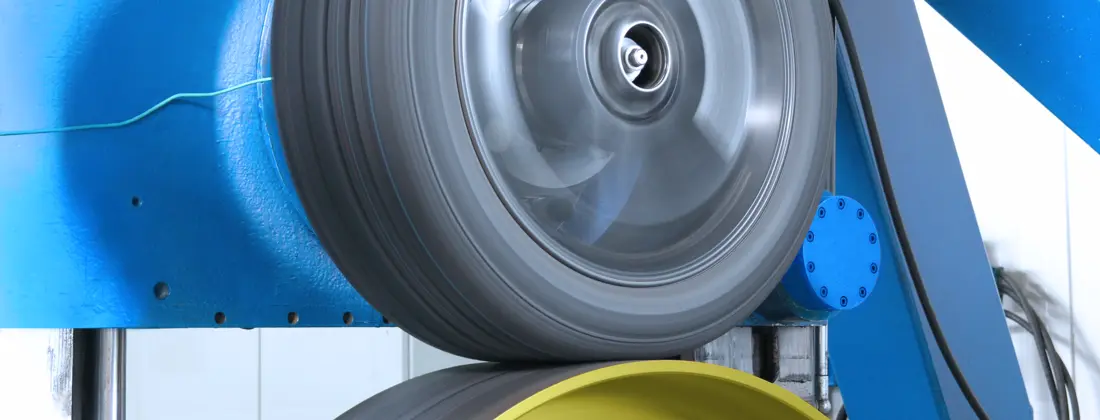EN 14247 Tyre Endurance Durability Testing
The European Standard EN 14247 specifies the procedure and requirements for tyre endurance durability testing. This test is crucial in ensuring that tyres meet stringent safety, performance, and reliability standards before they are approved for commercial use.
EN 14247 defines a comprehensive set of procedures to evaluate the endurance and durability of tyres under various conditions, including high-speed driving, prolonged exposure to environmental factors such as temperature and humidity, and cyclic loading. The test aims to simulate real-world operational conditions that tyres encounter during their lifespan.
The tyre specimens used in this testing are subjected to a series of cycles involving repeated loading and unloading until failure or the specified number of cycles is reached. This endurance testing ensures that tyres can withstand the stresses imposed by different driving conditions, including braking, accelerating, cornering, and long-distance travel.
Key parameters for EN 14247 include:
- Test duration: Typically up to 50,000 cycles
- Load application: Cyclic loading with specified maximum and minimum pressures
- Environmental conditions: Controlled temperature and humidity environments
- Cycling frequency: Specified number of cycles per day
The testing apparatus used in this process includes advanced tyre testers capable of simulating real-world driving scenarios. These machines ensure that tyres are subjected to the same stresses they would face during normal use, providing a realistic evaluation of their performance and durability.
During the test, various data points are collected and analyzed, including:
- Load deformation
- Temperature rise in the tyre
- Vibration levels
- Slip angles during cycling
The test results must meet strict acceptance criteria defined by EN 14247. Acceptance is based on:
- No tyre failures before reaching the specified number of cycles
- Residual tyre properties within acceptable limits post-testing
- Passing of all relevant safety checks and performance evaluations
The test is particularly important for ensuring that tyres are safe, reliable, and perform well under various conditions. Compliance with EN 14247 is mandatory for tyre manufacturers looking to meet regulatory requirements and ensure product quality.
EN 14247 testing can also help in:
- Identifying weak points in the tyre design
- Prediction of tyre lifespan under real-world conditions
- Improving material selection and manufacturing processes
Benefits
The benefits of EN 14247 tyre endurance durability testing are manifold, offering significant advantages to both manufacturers and consumers. For manufacturers:
Firstly, this test ensures that tyres meet the highest safety standards before they reach the market. This compliance with international regulations can prevent recalls and improve brand reputation.
Secondly, it allows for the optimization of tyre designs and materials. By identifying weaknesses in the current design or material composition, manufacturers can make necessary adjustments to enhance performance and durability.
For consumers, the primary benefit is enhanced safety while driving. Knowing that tyres have undergone rigorous testing ensures that they are less likely to fail during critical moments on the road. Additionally, this test helps in extending tyre lifespan, which translates into cost savings for the consumer.
Why Choose This Test
Selecting EN 14247 tyre endurance durability testing is a strategic decision that offers numerous advantages. Firstly, it ensures compliance with international standards and regulations. Compliance with these standards is crucial for market entry in many countries.
Secondly, the test provides a robust evaluation of tyre performance under various conditions. This comprehensive assessment helps manufacturers identify any potential issues early on, allowing for timely corrections before production begins.
The third advantage lies in its ability to predict real-world tyre behaviour accurately. By simulating driving conditions that tyres will encounter during their lifespan, the test ensures that tyres perform as expected under actual use.
Lastly, this testing can help manufacturers differentiate themselves in a competitive market by offering superior quality products. Consumers are increasingly aware of product quality and reliability, making EN 14247 compliance an attractive feature for marketing purposes.
Environmental and Sustainability Contributions
The adoption of EN 14247 tyre endurance durability testing contributes significantly to environmental sustainability. By ensuring that tyres are durable and reliable, the test reduces the number of premature tyre replacements. This reduction in waste is beneficial for the environment as it minimizes the amount of discarded tyres.
Moreover, the optimization of tyre design through this testing helps reduce fuel consumption. Durable tyres maintain optimal traction and rolling resistance, which can lead to better fuel efficiency when driving. Improved fuel efficiency not only reduces a vehicle's carbon footprint but also saves money for the consumer.
The test also encourages the use of sustainable materials in tyre manufacturing. By identifying the best materials through rigorous testing, manufacturers are more likely to choose eco-friendly options that have less environmental impact during production and disposal.





